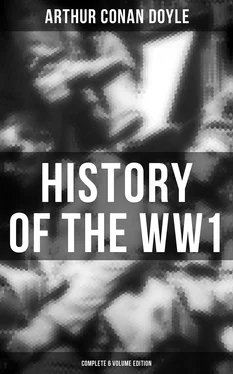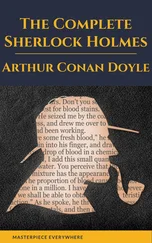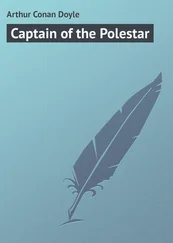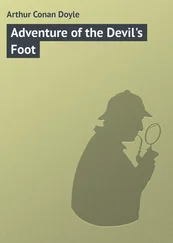The first sign of success for the strenuous German efforts upon October 30 was the driving in of Kavanagh’s 7th Guards’ Cavalry Brigade from their trenches at the Zandvoorde Ridge. On this ridge. which is not more than a hundred and twenty feet high, the Germans concentrated so tremendous and accurate a fire that the trenches were in many places demolished and became entirely untenable. The survivors of the Life Guards and Blues who made up this brigade withdrew steadily through the reserve trenches, which were held by the 6th cavalry Brigade, and reformed at Klein Zillebeke in the rear. Two squadrons, however, and Lord Worsley’s machine-gun section were killed or taken by the assailants. The unoccupied trenches were seized by the Sixth Bavarian Reserve Division, who advanced rapidly in order to improve their advantage, while their artillery began to pound the reserves. The cavalry had been strengthened, however, by the Greys and 3rd Hussars upon the left, while the 4th Hussars lined up on the right, and C, I, and K Horse Artillery batteries vigorously supported. In spite of great pressure, the position was held. Farther south the First Cavalry Division was also at very close grips with the Twenty-sixth Division of the Thirteenth German Army Corps, and was hard put to it to hold its own. Along the whole cavalry position there was extreme strain. A squadron of the 1st Royals were forced to evacuate the château of Holebeke, and the line in this quarter was pushed back as far as St. Eloi, thus flattening a considerable salient.
The danger of a position which consists of so long a line with few reserves is that any retirement at any point immediately exposes the flanks of the neighbouring units to right and left. Thus the evacuation of Zandvoorde threw open the right flank of the Seventh Division, even as its left had been in the air upon the day before. On getting through, the Germans were on the right rear of the 1st Welsh Fusiliers and enfiladed them badly, destroying all the officers and a first considerable proportion of the regiment, which had already been greatly reduced. Colonel Cadogan was among those who fell. The 22nd Brigade was forced to fall back, and the 2nd Yorkshires and 2nd Scots Fusiliers, of the 21st Brigade, being left in a salient, suffered heavily, especially the latter battalion, the conduct of which from first to last was remarkable even among such men as fought beside them. These two regiments held on with the greatest determination until orders to retire reached them, which were somewhat belated, as several orderlies were killed in bringing them. The 2nd Bedfords, who had themselves sustained very severe losses from the German artillery fire, covered the retirement of the remains of these two gallant units. The Seventh Division then covered the line from the canal through Klein Zillebeke and along the front of the woods to near Gheluvelt.
The position was now most critical. The Germans were in possession of Zandvoorde Ridge on the British right flank, a most important position whence guns could command a considerable area. Ypres was only four miles distant. There was nothing but a line of weary and partially broken infantry to protect the flank from being entirely pierced. The whole of a German active army corps was attacking upon this line. The order was given to hold the new positions at all costs, but on the evening of the 30th the situation was full of menace for the morrow. The German flood was still thundering against the barrier, and the barrier seemed to be giving. At about 2 P.M. on October 30 the 1st Irish Guards and the 2nd Grenadiers, who were in reserve to two battalions of the Coldstream in trenches in the Polygon Wood, near Reutel Village, were ordered to help the Seventh Division. General Capper subsequently directed them to take the place of the cavalry on the right of his division. The Irish Guards were accordingly on the right of the Seventh Division from now onwards, and the Grenadiers were on their right, extending down to the canal in front of Klein Zillebeke. The commander of the Ninth French Corps also, with that fine loyalty which his comrades have shown again and again during the war, easing many a difficult and perhaps saving some impossible situations, put three battalions and some cavalry at the disposal of the British. Two regiments of Bulfin’s 2nd Brigade were also brought across and thrust into the gap. But the outlook that evening was not cheering. The troops had been fighting hard for two days without a break. The losses had been heavy. The line had been driven back and was greatly strained. It was known that the Germans were in great strength and that the attack would be renewed on the morrow. The troops and their leaders faced the immediate future in a spirit of sombre determination.
During the 30th Landon’s Brigade had strengthened their position near Gheluvelt, and General Haig, realising that this was the key of his line, moved up the 2nd King’s Royal Rifles and the 1st North Lancashires to form a reserve under the orders of General Landon. These regiments took a position south-west of Gheluvelt and connected up more closely between the Seventh Division and the 3rd Brigade of the First Division. It was well that a closely-knitted line had been formed, for at the dawn of day upon the 31st a most terrific attack was made, which was pushed with unexampled fierceness during the whole day, falling chiefly upon the centre and left of the Seventh Division and upon the 1st Queen’s and 2nd Welsh of the Third Brigade.
A weak point developed, unfortunately, in the front line, for the Seventh Division in its enfeebled condition was further weakened by forming somewhat of a salient in the Kruiseik direction. They behaved with all their usual magnificent gallantry, but they were not numerous enough to hold the ground. The line was broken and the remains of the 2nd Royal Scots Fusiliers, after being exposed to heavy fire from 5:30 A.M., were outflanked and surrounded in the early afternoon. The bulk of the survivors of this battalion had been sent to reinforce the line elsewhere, but the remainder, some sixty in number, were killed, wounded, or taken, including their gallant colonel, Baird Smith, who had been hit the day before. The Picton tradition which disregards wounds unless they are absolutely crippling was continually observed by these stern soldiers. On the left of the Scots Fusiliers the 2nd Bedfords were also involved in the catastrophe, but drew off with heavy losses.
The left wing of the Seventh Division began to retire, and the 1st Queen’s upon the right of the 3rd Brigade had both their flanks turned and were reduced to a handful under Major Watson and Lieutenant Boyd, who still held together as a unit. It was a great morning in the history of this regiment, as the two battalions had fought side by side, and their colonels. Pell and Coles, had both fallen in the action.
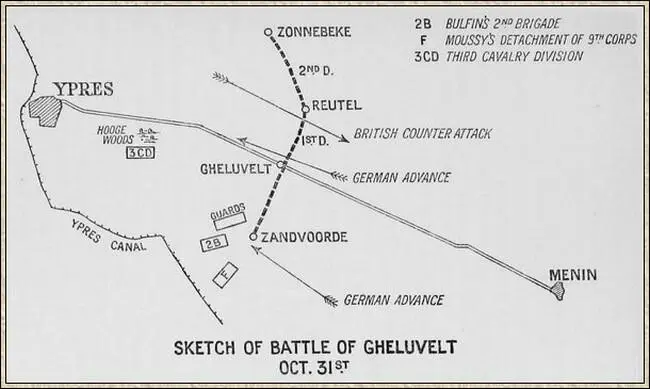
Sketch of Battle of Gheluvelt, October 31
The line of the 3rd Brigade had been drawn up across the Menin road some four hundred yards to the east of the village. The road itself was held by the 2nd Welsh Regiment, supported by the 54th Battery (Major Peel), which was immediately behind the village. Both the battalion and the battery fought desperately in a most exposed situation. The Welsh Regiment were driven out of their trenches by a terrific shell-fire followed by an infantry attack. They lost during the day nearly six hundred men, with sixteen officers, killed, wounded, or missing. Colonel Morland was killed and Major Prichard badly wounded. Finally, after being pushed back, holding every possible point, they formed up under Captain Rees across the open in a thin skirmishing line to cover the battery, which was doing great work by holding back the German advance. One German gun was in action upon the Menin road. Lieutenant Blewitt took a British gun out on to the bare road to face it, and a duel ensued at five hundred yards, which ended by the German gun being knocked out at the third shot by a direct hit.
Читать дальше
